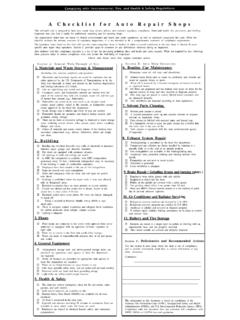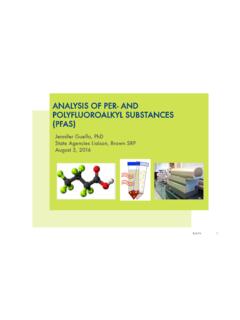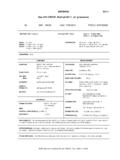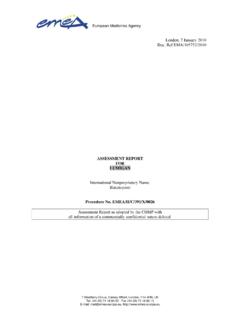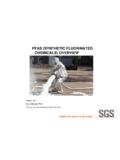Transcription of NEWMOA PFAS Webinar Aug 2016 rev2
1 PFAS SamplingPresenter:Dora Chiang, , :Katherine Davis, AucoinDorin Bogdan, WoodwardAugust 3, 201622 Background LevelsWhere Do We Find PFASs?Where to we find PFASs?33 Background LevelsPerfluorocarboxylic Acid Content in 116 Articles of CommerceUSEPA Study, March 2009 EPA/600/R-09/03344 Class of PFAS Compoundsin AFFF Formulations(Zwitterionic, Cationic, and Anionic Fluorinated Chemicals in Aqueous Film Forming Foam Formulations and Groundwater from Military Bases by NonaqueousLarge-Volume Injection HPLC-MS/MS, Will J. Backe, Thomas C. Day, and Jennifer A. Field, Environ. Sci. Technol., 2013, 47 (10), pp 5226 5234.)55 PFOS/PFOA Health Advisories 70 parts per trillion = 70/1,000,000,000,000 World Population = billion 70 ppt ~ 1 person / 2 world populationsSense of Ongoing EvolutionInvestigation/ More InvestigationLower PFAS Detection LimitsMore Toxicology Data Changing Composition in ManufacturingRegulatory Decision MakingMore PFAS AnalytesTreatment TechnologiesParts Per Trillion (ng/L)Communicate the RiskRisk = Hazard + Outrage(Sandman, 1987)77Pl What are required and recommended when sampling for PFASs?
2 Where to sample for PFASs? Which PFASs to analyze for? Can we trust the data (cross-contamination)?PFAS Sampling for WaterPlanning Field Crew Training Sampling Tracking Data Change Data Interpretation& Analyses with Time& Reporting PFAS Sampling88 Example PFAS sampling references USEPA Method 537 Perfluorocarboxylic Acid Content in 116 Articles of Commerce, EPA/600/R-09/033 Navy Field Sampling Protocols for PFCs Perfluorochemical (PFC) Field Sampling Protocol, Transport Canada, 2013 Interim Guideline on the Assessment and Management of Perfluoroalkyl and, Polyfluoroalkyl Substances (PFAS), Department of Environment Regulation, Western Australia, 2016 State Contact laboratory Develop quality assurance documents Conduct field crew training classes Site-specific work plan development on sampling strategyPlanning for PFAS Sampling Regulators Project managers Field technicians Water supply system operation personnel Site safety officers99 Many Precautions for Sampling Procedures Don t Have Scientific Data To Prove The Concerns we Extremely low reporting and regulatory limits magnify the importance of cross contamination Trace background PFAS levels can be detected Uncertainties on the patterns of PFAS released from the PFAS materials remain unknown Trace PFAS levels are detected in some drinking water systemsBecause we Stable chemistry.
3 Unlikely to be released under most conditions The PFAS levels from cross contamination cannot be quantified Manufacturing of PFOA and PFOS have been phased out between 2010-20151010 PFAS Sampling1111 The Field CrewDo Not UseAcceptable AlternativesWearing/using personnel hygiene items (cosmetics, lotions, moisturizers) Do not wearSunscreens, insect repellantsLong sleeve, light colored 100% cotton shirts, wide brimmed hats, products that are 100% natural ingredients, DEET, tuck pant legs into socks and/or boots and use duct tapeNew or unwashed clothingWell-washed clothingClothing washed in fabric softenersClothing not washed with fabric softenersTreated clothing (waterproof, water resistant, stain-resistant)Clothing made of synthetic or natural fibersTreated boots (waterproof, water resistant, stain-resistant)Steel-toed boots made with polyurethane and polyvinyl chloride (PVC).
4 Coated Tyvek suits*Tyvek suitsHanding or prepackaged food productsDo not have at the sampling location, wash hands well after handling, wear powderless nitrile gloves 1212 Many manufactured sunblock and insect repellants contain PFASs and should not be brought or used on-site. The following products are acceptable: Sunscreens - Alba Organics Natural Sunscreen, Yes To Cucumbers, Aubrey Organics, Jason Natural Sun Block, Kiss my face, and baby sunscreens that are free or natural Insect Repellents - Jason Natural Quit Bugging Me, Repel Lemon Eucalyptus Insect repellant, Herbal Armor, California Baby Natural Bug Spray, BabyGanics Sunscreen and insect repellant - Avon Skin So Soft Bug Guard Plus SPF 30 LotionSunscreens and Insect Repellants ..The highest concentrations of PFOS and PFOA were detected at ng/g and ng/g, respectively.
5 Even though present concentrations are found at ng/g levels, the daily use of sunscreen products is normally several grams. Therefore, a risk assessment of PFOS and PFOA contamination in sunscreen products is an important concern, and more attention needs to be paid to the long-term effects on human health. -2015 The concentrations of total PFCAs ranged from not detected to gg 1for cosmetics and from not detected to 19 gg 1for sunscreens Chemosphere, 20131313 Sampling Equipment Do Not UseAcceptable AlternativesFluoropolymer bailers or pump bladdersDisposable EquipmentDedicated Equipment (no PTFE parts)Fluoropolymer tubing, valves and other parts in pumps High-density polyethylene (HDPE) and silicon materials ( tubing). LDPE HydraSleevesHDPE HydraSleevesDecon 90 Alconox and Liquinox soap for decontamination, if neededDecontamination water from the siteWater used for the decontamination of sampling equipment will be laboratory certified "PFAS-free" waterGlass containers (due to potential loss of analyte through adsorptionPolypropylene or HDPE sample bottles fitted with an unlined (no PTFE), polypropylene or HDPE screw capWaterproof field books Loose paper on aluminum clipboardsSharpies (acceptable by EPA checklist)Ball point pensPost-it notesBlue (chemical) ice*Ice contained in plastic (polyethylene) bags (double bagged))
6 , secured to avoid meltwater from contacting sample containers, overnight shippingAluminum foilThin HDPE sheeting can be used1414 Prior to collection of samples, field personnel must wash their hands and wear a new set of nitrile gloves Do not filter samples Shaker Test:A small portion of the sample (~10-25 mL) should be shaken by the sample collector on site. If foaming is noted within the sample, this should be documented when samples are submitted for analysis Field QA/QC Samples !! Field blanks (bottle to bottle) Equipment blanks (rinsate) Trip or travel blankSample CollectionPFOA Site FS/DUPEB/FBEB hits >RLA (landfill)209320B (landfill)77212C (landfill)99213D637220E823340 AFFF SiteSample TypeSamples AnalyzedPFAS detected# detectionsPFAS Analytes detectedResult (min-max)Field Blank11No000 Equipment Blank115 Yes3 PFOS, 6.
7 2 g/L1515 Don t use detergent to decon drilling equipment, scrub with a plastic brush and rinse thoroughly in tap water, then triple-rinse in distilled or deionized water Use PFAS-free drilling fluids Don t re-use PVC well material which has been used previously at sites where PFAS is known or suspected to be present Collect representative water sample used during drilling activities Purged groundwater must be drummed, transported and managed properly Surface water must be collected by inserting a capped sampling container (polypropylene or HDPE) with the opening pointing down to avoid the collection of surface films Soil and sediment core samples must be collected directly from single-use PVC liners that must not be decontaminated or reused at different locationsDrilling, Well Redevelopment, Surface Water Sampling1616 No food or drink shall be brought on-site, with the exception of bottled water and hydration drinks ( , Gatorade and Powerade ) and available for consumption only in the staging area.
8 When field personnel require a break to eat or drink, they should remove their gloves and coveralls and move to an appropriate location (preferably downwind). When finished, field personnel should then tidy up and put their coveralls and gloves back on prior to returning to the work area. Visitors to the site are asked to remain at least 30 feet from sampling Considerations1717 Recommended PFAS Sampling Strategy1. Drinking water2. Surface water3. Groundwater1) upgradient well(s). 2) furthest downgradient of the interpreted or known source. 3) downgradient to source4) the wells closest to the interpreted or known source are sampled dilute plume intercepting multiple sensitive receptors1818 Multiple Transport Mechanisms PFOA Releases From a Fluoropolymer Manufacturing Facility1919 Environmental ConditionsPFASs at AFFF Release SitesREDOX ZONATION 300mV 200mV 100mV0 mV100 mV 200 mVShorter chain PFASs become more mobileGroundwater FlowFuelsPFASsFire Training AreaPrecursors Oxidize & Dead End at PFOS/PFOAH ydrocarbons biodegrade rapidlyHigh BOD PFASs extend anaerobic zone2020 Precursors Biotransformation6:2 Fluorotelomer Biotransformation Pathways Converge2121 Known PFOS SourcesWhat s this?
9 AFFF Precursor Oxidation Impact on PFOS Concentrations2222 Contaminated Sites with Potential PFAS Impact Active AFFF uses and unprotected storage Remediation induced conditions can alter biotransformation of PFAS precursors (McGuire et al, ES&T, 2014), such as:oAir/oxygen spargingoPump and treatoIn-situ chemical oxidation Surface and groundwater investigation program (uses of PTFE materials for VOC sampling) Off-Site Sampling Private well installation Cross contamination from household and personal use items which may contain PFASsHow PFAS Data Can Change with Time2323 Identify sources of cross contamination in the field and lab environments Evaluate sampling protocols including field equipment and clothing in the field and collect banks At PFAS impacted sites, practice consistently to avoid cross contamination early for site-wide investigation program Use a lab with proven PFAS experience and understanding of potential PFAS contamination sources and PFAS analytical issues Document field practice changes to account for potential data variations between PFAS sampling events Need scientific data to document the PFAS impact from the personal protection and field equipment.
10 Remove or add precautions when more science evolves PFAS Sampling Summary Thank You!Dora Chiang, , 405-1214 The significant problems we face cannot be solved at the same level of thinking we were at when we created them. Jennifer Guelfo, PhDState Agencies LiaisonSuperfund Research ProgramBrown Providence, RIPhone: (401) 680-0835Q & ADora Chiang, PhD, PEDirector of Emerging ContaminantsAECOM Atlanta, GAPhone: (404) 405-1214
